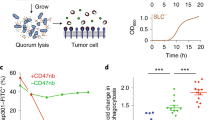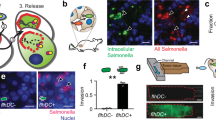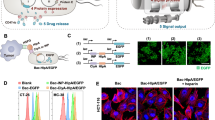Abstract
The efficacy of current anti-cancer gene therapies is limited by the inability of gene vectors to penetrate the poorly vascularized, hypoxic regions of tumors, leaving these sites untreated. We describe a new approach for targeting gene therapy to these sites, which employs an attenuated strain of the non-pathogenic bacterium, Salmonella typhimurium, carrying an exogenous (that is, reporter or therapeutic) gene under the regulation of a new, highly hypoxia-inducible promoter (FF+20*). This bacterial vector was seen to rapidly migrate into, and thrive in, hypoxic areas of both mammary tumor spheroids grown in vitro and orthotopic mammary tumors after systemic injection. Using the reporter gene construct, FF+20*-lacZ, we show that bacterial expression of high levels of β-galactosidase occurred only in hypoxic/necrotic sites of spheroids and tumors. We then replaced the reporter gene with one encoding a novel cytotoxic protein (HlyE) and showed that this was also expressed by bacteria only in hypoxic regions of murine mammary tumors. This resulted in a marked increase in tumor necrosis and reduced tumor growth. Our system represents a promising new strategy for delivering gene therapy to poorly vascularized regions of tumors and shows, for the first time, the efficacy of HlyE as an anti-tumor agent.
This is a preview of subscription content, access via your institution
Access options
Subscribe to this journal
Receive 12 print issues and online access
$259.00 per year
only $21.58 per issue
Buy this article
- Purchase on Springer Link
- Instant access to full article PDF
Prices may be subject to local taxes which are calculated during checkout





Similar content being viewed by others
References
Brown JM . The hypoxic cell: a target for selective cancer therapy—eighteenth Bruce F. Cain Memorial Award lecture. Cancer Res 1999; 59: 5863–5870.
Vaupel PW, Hockel M . Oxygenation Status of Humans Tumours: A Reappraisal Using Computerized pO2 Histography. Gustav Fischer Verlag: Germany, 1995.
Ryan RM, Green J, Lewis CE . Use of bacteria in anti-cancer therapies. Bioessays 2006; 28: 84–94.
Clairmont C, Lee KC, Pike J, Ittensohn M, Low KB, Pawelek J et al. Biodistribution and genetic stability of the novel antitumor agent VNP20009, a genetically modified strain of Salmonella typhimurium. J Infect Dis 2000; 181: 1996–2002.
Low KB, Ittensohn M, Le T, Platt J, Sodi S, Amoss M et al. Lipid A mutant Salmonella with suppressed virulence and TNFα induction retain tumor-targeting in vivo. Nat Biotechnol 1999; 17: 37–41.
Pawelek JM, Low KB, Bermudes D . Tumor-targeted Salmonella as a novel anticancer vector. Cancer Res 1997; 57: 4537–4544.
Rosenberg SA, Spiess PJ, Kleiner DE . Antitumor effects in mice of the intravenous injection of attenuated Salmonella typhimurium. J Immunother 2002; 25: 218–225.
Green J, Bennett B, Jordan P, Ralph ET, Thomson AJ, Guest JR . Reconstitution of the [4Fe-4S] cluster in FNR and demonstration of the aerobic-anaerobic transcription switch in vitro. Biochem J 1996; 316 (Pt 3): 887–892.
Khoroshilova N, Beinert H, Kiley PJ . Association of a polynuclear iron-sulfur center with a mutant FNR protein enhances DNA binding. Proc Natl Acad Sci USA 1995; 92: 2499–2503.
Jordan PA, Thomson AJ, Ralph ET, Guest JR, Green J . FNR is a direct oxygen sensor having a biphasic response curve. FEBS Lett 1997; 416: 349–352.
Kiley PJ, Beinert H . The role of Fe-S proteins in sensing and regulation in bacteria. Curr Opin Microbiol 2003; 6: 181–185.
del Castillo FJ, Leal SC, Moreno F, del Castillo I . The Escherichia coli K-12 sheA gene encodes a 34-kDa secreted haemolysin. Mol Microbiol 1997; 25: 107–115.
Ludwig A, Tengel C, Bauer S, Bubert A, Benz R, Mollenkopf HJ et al. SlyA, a regulatory protein from Salmonella typhimurium, induces a haemolytic and pore-forming protein in Escherichia coli. Mol Gen Genet 1995; 249: 474–486.
Oscarsson J, Mizunoe Y, Uhlin BE, Haydon DJ . Induction of haemolytic activity in Escherichia coli by the slyA gene product. Mol Microbiol 1996; 20: 191–199.
Bjornheden T, Levin M, Evaldsson M, Wiklund O . Evidence of hypoxic areas within the arterial wall in vivo. Arterioscler Thromb Vasc Biol 1999; 19: 870–876.
Kivisaari J, Niinikoski J . Effects of hyperbaric oxygenation and prolonged hypoxia on the healing of open wounds. Acta Chir Scand 1975; 141: 14–19.
Stevens CR, Williams RB, Farrell AJ, Blake DR . Hypoxia and inflammatory synovitis: observations and speculation. Ann Rheum Dis 1991; 50: 124–132.
Vaupel P, Kallinowski F, Okunieff P . Blood flow, oxygen and nutrient supply, and metabolic microenvironment of human tumors: a review. Cancer Res 1989; 49: 6449–6465.
Hoiseth SK, Stocker BA . Aromatic-dependent Salmonella typhimurium are non-virulent and effective as live vaccines. Nature 1981; 291: 238–239.
Khan SA, Everest P, Servos S, Foxwell N, Zahringer U, Brade H et al. A lethal role for lipid A in Salmonella infections. Mol Microbiol 1998; 29: 571–579.
del Castillo FJ, Moreno F, del Castillo I . Characterization of the genes encoding the sheA haemolysin in Escherichia coli O157:H7 and Shigella flexneri 2a. Res Microbiol 2000; 151: 229–230.
Oscarsson J, Westermark M, Lofdahl S, Olsen B, Palmgren H, Mizunoe Y et al. Characterization of a pore-forming cytotoxin expressed by Salmonella enterica serovars typhi and paratyphi A. Infect Immun 2002; 70: 5759–5769.
Ludwig A, Bauer S, Benz R, Bergmann B, Goebel W . Analysis of the slyA-controlled expression, subcellular localization and pore-forming activity of a 34 kDa haemolysin (ClyA) from Escherichia coli K-12. Mol Microbiol 1999; 31: 557–567.
Oscarsson J, Mizunoe Y, Li L, Lai XH, Wieslander A, Uhlin BE . Molecular analysis of the cytolytic protein ClyA (sheA) from Escherichia coli. Mol Microbiol 1999; 32: 1226–1238.
Pecota DC, Kim CS, Wu K, Gerdes K, Wood TK . Combining the hok/sok, parDE, and pnd postsegregational killer loci to enhance plasmid stability. Appl Environ Microbiol 1997; 63: 1917–1924.
Janat-Amsbury MM, Yockman JW, Lee M, Kern S, Furgeson DY, Bikram M et al. Combination of local, nonviral IL12 gene therapy and systemic paclitaxel treatment in a metastatic breast cancer model. Mol Ther 2004; 9: 829–836.
Scholl S, Squiban P, Bizouarne N, Baudin M, Acres B, Von Mensdorff-Pouilly S et al. Metastatic breast tumour regression following treatment by a gene-modified vaccinia virus expressing MUC1 and IL-2. J Biomed Biotechnol 2003; 2003: 194–201.
Yu D, Ellis HM, Lee EC, Jenkins NA, Copeland NG, Court DL . An efficient recombination system for chromosome engineering in Escherichia coli. Proc Natl Acad Sci USA 2000; 97: 5978–5983.
Toso JF, Gill VJ, Hwu P, Marincola FM, Restifo NP, Schwartzentruber DJ et al. Phase I study of the intravenous administration of attenuated Salmonella typhimurium to patients with metastatic melanoma. J Clin Oncol 2002; 20: 142–152.
Bugelski PJ, Kirsh R, Buscarino C, Corwin SP, Poste G . Recruitment of exogenous macrophages into metastases at different stages of tumor growth. Cancer Immunol Immunother 1987; 24: 93–98.
Dang LH, Bettegowda C, Huso DL, Kinzler KW, Vogelstein B . Combination bacteriolytic therapy for the treatment of experimental tumors. Proc Natl Acad Sci USA 2001; 98: 15155–15160.
Dachs GU, Dougherty GJ, Stratford IJ, Chaplin DJ . Targeting gene therapy to cancer: a review. Oncol Res 1997; 9: 313–325.
Greco O, Marples B, Dachs GU, Williams KJ, Patterson AV, Scott SD . Novel chimeric gene promoters responsive to hypoxia and ionizing radiation. Gene Therapy 2002; 9: 1403–1411.
Mengesha A, Dubois L, Lambin P, Landuyt W, Chiu RK, Wouters BG et al. Development of a flexible and potent hypoxia-inducible promoter for tumor-targeted gene expression in attenuated Salmonella. Cancer Biol Ther 2006; 5: 1120–1128.
Atkins A, Wyborn NR, Wallace AJ, Stillman TJ, Black LK, Fielding AB et al. Structure-function relationships of a novel bacterial toxin, hemolysin E. The role of alpha G. J Biol Chem 2000; 275: 41150–41155.
Pettit GR, Singh SB, Hamel E, Lin CM, Alberts DS, Garcia-Kendall D . Isolation and structure of the strong cell growth and tubulin inhibitor combretastatin A-4. Experientia 1989; 45: 209–211.
Lodge J, Williams R, Bell A, Chan B, Busby S . Comparison of promoter activities in Escherichia coli and Pseudomonas aeruginosa: use of a new broad-host-range promoter-probe plasmid. FEMS Microbiol Lett 1990; 55: 221–225.
Bell A, Busby S . Location and orientation of an activating region in the Escherichia coli transcription factor, FNR. Mol Microbiol 1994; 11: 383–390.
Hutchison III CA, Phillips S, Edgell MH, Gillam S, Jahnke P, Smith M . Mutagenesis at a specific position in a DNA sequence. J Biol Chem 1978; 253: 6551–6560.
Wyborn NR, Clark A, Roberts RE, Jamieson SJ, Tzokov S, Bullough PA et al. Properties of haemolysin E (HlyE) from a pathogenic Escherichia coli avian isolate and studies of HlyE export. Microbiology 2004; 150: 1495–1505.
Norte VA, Stapleton MR, Green J . PhoP-responsive expression of the Salmonella enterica serovar Typhimurium slyA gene. J Bacteriol 2003; 185: 3508–3514.
Pidgeon GP, Harmey JH, Kay E, Da Costa M, Redmond HP, Bouchier-Hayes DJ . The role of endotoxin/lipopolysaccharide in surgically induced tumour growth in a murine model of metastatic disease. Br J Cancer 1999; 81: 1311–1317.
Miller J . Assay of B-galactosidase. Cold Spring Horbor Laboratory Press: New York, 1972.
Burke B, Giannoudis A, Corke KP, Gill D, Wells M, Ziegler-Heitbrock L et al. Hypoxia-induced gene expression in human macrophages: implications for ischemic tissues and hypoxia-regulated gene therapy. Am J Pathol 2003; 163: 1233–1243.
Serganova I, Doubrovin M, Vider J, Ponomarev V, Soghomonyan S, Beresten T et al. Molecular imaging of temporal dynamics and spatial heterogeneity of hypoxia-inducible factor-1 signal transduction activity in tumors in living mice. Cancer Res 2004; 64: 6101–6108.
Griffiths L, Binley K, Iqball S, Kan O, Maxwell P, Ratcliffe P et al. The macrophage—a novel system to deliver gene therapy to pathological hypoxia. Gene Therapy 2000; 7: 255–262.
Laemmli UK . Cleavage of structural proteins during the assembly of the head of bacteriophage T4. Nature 1970; 227: 680–685.
Shabsigh A, Ghafar MA, de la Taille A, Burchardt M, Kaplan SA, Anastasiadis AG et al. Biomarker analysis demonstrates a hypoxic environment in the castrated rat ventral prostate gland. J Cell Biochem 2001; 81: 437–444.
Raleigh JA, Chou SC, Tables L, Suchindran S, Varia MA, Horsman MR . Relationship of hypoxia to metallothionein expression in murine tumors. Int J Radiat Oncol Biol Phys 1998; 42: 727–730.
Acknowledgements
We thank James Raleigh (University of North Carolina) for the polyclonal pimonidazole antibody; Duncan Maskell (University of Cambridge) for S. typhimurium strain SL3261; Ken Gerdes (University of South Denmark) for plasmids; Derek Borwick and Martin Dunphy for technical assistance with the in vivo experiments; Yorkshire Cancer Research (UK), the Biotechnology and Biological Sciences Research Council, UK and the Irish Research Council for Science, Engineering and Technology (PD/2002/87) for their financial support.
Author information
Authors and Affiliations
Corresponding author
Rights and permissions
About this article
Cite this article
Ryan, R., Green, J., Williams, P. et al. Bacterial delivery of a novel cytolysin to hypoxic areas of solid tumors. Gene Ther 16, 329–339 (2009). https://doi.org/10.1038/gt.2008.188
Received:
Revised:
Accepted:
Published:
Issue Date:
DOI: https://doi.org/10.1038/gt.2008.188
Keywords
This article is cited by
-
Promising dawn in tumor microenvironment therapy: engineering oral bacteria
International Journal of Oral Science (2024)
-
Enhancing tumor-specific recognition of programmable synthetic bacterial consortium for precision therapy of colorectal cancer
npj Biofilms and Microbiomes (2024)
-
Current advances in microbial-based cancer therapies
Medical Oncology (2023)
-
Multicolor multifocal 3D microscopy using in-situ optimization of a spatial light modulator
Scientific Reports (2022)
-
A rapid screening platform to coculture bacteria within tumor spheroids
Nature Protocols (2022)



